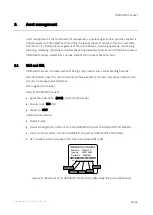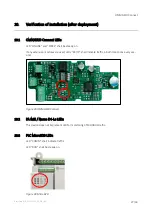
OMNIGRID Connect
Kamstrup A/S · 5512-2065_A1_GB_BSI
12/33
5.
Wiring
A maximum of four wire pairs are needed to interconnect OMNIGRID Connect with sensors and
extension modules. The specific need for connections depends on use.
Figure 7: OMNICON Connect PCB and terminal block outline.
Use 0.75 mm
2
or 1 mm
2
(AWG 18/19 or AWG 17) unshielded cable; stranded or single core.
If needed, use a colour-coding scheme if required in relation to local legislation – cable colouring is
not defined within this document.
•
RS-485
137 A/- and 138 B/+: Twisted pair.
•
Analog input (earth fault current)
+A and -A: Twisted pair.
•
Digital intup1
+65 and -66: Twisted or non-twisted.
•
Digital input2
+67 and -68: Twisted or non-twisted.
-68 is preferred to be the same colour as -66.
PCB terminals are based on
Phoenix Contact type MKDS 1/ 2-3,81 (www.phoenixcontact.com)
.
Key parameters:
•
Tightening torque between 0.22 Nm and 0.25 Nm.
•
Stripping length: 5 mm.
It is recommended to reduce the lengths of cables to a minimum.
Splices in cables should be avoided whenever possible. Splices are prime areas for corrosion, loose
connections and introduction of electromagnetic noise. A single, unbroken cable from OMNIGRID
Connect to the sensor and extension modules is always the most reliable solution.
Be careful when installing low-voltage wiring in proximity to higher voltage wiring. Any wires carry-
ing an AC signal of more than 120VAC are a possible source of electromagnetic interference, and
instrument signal cables should be installed a safe distance from them. If low-voltage cable must
cross over AC power, the two should be separated by an adequate distance, and the crossing
should be made at right angles to minimize induction.
The terminal block for OMNICON® 2G Modem shown in Figure 7 shall not be used.













































